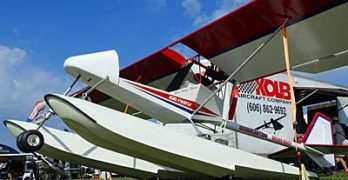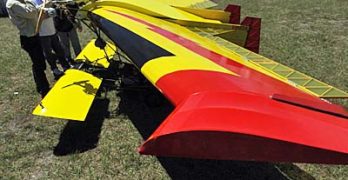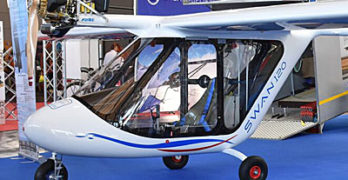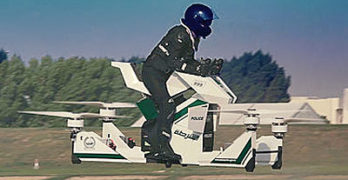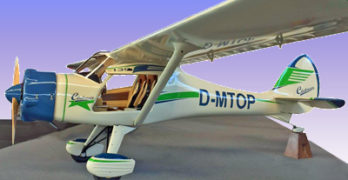For your enjoyment, here is arguably the most unique airplane I found on the grounds of EAA AirVenture Oshkosh 2018 …and with around 3,000 show planes, that is truly saying something.
This aircraft is made almost entirely of foam sheets that you can buy at Home Depot or Lowe’s. It uses two electric motors for thrust. The aircraft is a biplane taildragger. Batteries provide the fuel.
Plus, yes, it actually flies! Catch some of the action in two videos below.
Award Winner?
This unusual arrangement was prepared for EAA’s tough judges. However it fared in that evaluation, this clearly wins an award in my mind for being highly original, unique, super affordable, and OK… it is rather delightfully weird, not that that I see anything wrong with that.
What you are seeing in the nearby photos and videos below is Peter Sripol‘s man-carrying scratch-built aircraft project.
Peter is a longtime modeler and homebuilder with a popular YouTube channel that boasts more than 650,000 subscribers!
Search Results for : Part 103
Not finding exactly what you expected? Try our advanced search option.
Select a manufacturer to go straight to all our content about that manufacturer.
Select an aircraft model to go straight to all our content about that model.
Kolb Firefly Ultralight Aircraft on Puddle Jumper Floats: Close to Perfection
Maybe you never flew a floatplane or seaplane (the latter implying a hull). If that’s true you are missing one of the singular pleasures of flying. Landing on water is almost unreal. It seems unlikely but when you find yourself about to touchdown on a lake, you know you have arrived in a way few people in history have ever considered much less achieved.
Alas, the cost of having that dream become reality is substantial. A general aviation floatplane easily runs half a million dollars new, probably much more. Even used, a floatplane is a very costly purchase. Because of their scarcity, a seaplane (with a hull) will cost you even more. Even the most modestly-priced LSA on floats can be a rather expensive proposition.
Along comes Part 103 to save the day. While Light-Sport are affordable compared to, say, a new Cessna 172 on amphibious floats, nothing can compare with Part 103 ultralight vehicles on wheels or floats.
Updated Lightning Bug — Affordable Homebuilt (2018)
Brian Austein did it again! He drew big crowds and head-shakes of amazement at what he has created for — get this — a mere $3,000. That’s his total investment, including twin engines that cost $1,000 each. Well, OK, that small amount of cash plus a lot of brainpower and plenty of hands-on effort. What this longtime radio-control model airplane builder showed with Lightning Bug was that you could indeed build a man-carrying Part 103 ultralight using RC engines. Now, or 2018, Brian updated the original Lightning Bug to carry slight heavier pilots. It still flies great and you have to see this video to believe all its wonderful features. No wonder he won two judges awards at Sun ‘n Fun 2017.
Spaceship or Ultralight Aircraft? Brian Austein’s Amazingly Affordable Project
For the second year in a row, I was blown away with Lightning Bug. It changed enough that I tagged it Lightning Bug 2 even if designer/developer Brian Austein did not call it that.
Let me make a key point: Lightning Bug was a $3,000 aircraft project, with the cost split between two engines — model radio control aircraft engines, by the way! — and $1,000 more for the airframe. The rest was Brian’s talent and drive to design and build the ultralight.
So, let’s recap. If you had Brian’s abilities, you could have an airplane for three grand. If you don’t find that amazing in a time of $150,000 (up to $350,000!) Light-Sport Aircraft, I don’t know what impresses you.
The unique airplane certainly impressed often hard-to-convince judges who gave it not one but two awards in 2017: Grand Champion and Best Innovation.
Lightning Bug was partly an experiment to prove, as Brian said, that “I could build a [man-carrying] airplane that could fly with RC model airplane engines.” Models have gotten ever larger, converging with Lightning Bug that weighs a mere 140 pounds (no, that’s not a typo).
Swan Ultralight — “Big Little Airplane” in a Tiny Box (Trailer)
For three years at Aero Friedrichshafen, the wonderful April show in the south of Germany, I have admired one genuine ultralight called Swan.
Yes, “ultralight!” Swan may not look like a U.S. “ultralight vehicle” as Part 103 rule writers deliberately named the type. Yet I use the term with care. So does the Swan producer.
The company is well aware of three national standards with which Swan neatly complies, they said: England’s SSDR or Single Seat DeRegulated, or Germany’s 120-kilogram class or FAA’s Part 103. These are all surprisingly similar (see this article for more). Swan may need to be equipped carefully to achieve this but the producer assured me it was possible.
Naturally, I get that not everyone is into ultralights and/or single seat aircraft. However, interest appears stronger than in many years. No doubt many potential buyers look closely at purchase prices they can afford while for those lucky enough to afford two airplanes, Swan could be their “sport” airplane as some spam can works to haul the family around.
Sun ‘n Fun 2018: Records Set, Sales Made, Customers Smiling
Sun ‘n Fun 2018 is done. The show actually closed early at about 1 PM due to forecasts of severe weather. Within hours, a bustling event began to look like a ghost town.
Despite the rushed finish, the event appeared to be a huge success. Reports were that it was a all-time record result for Sun ‘n Fun; we’ll wait to see the numbers to know more detail. My conversations with several vendors indicated strong sales interest and orders were taken, so customers and vendors both appear to be satisfied.
I spoke to many fans at the show and our conversations demonstrate to me that light aviation is very alive and well. In fact, I see this as one of the most invigorated periods in recent years. The interest is broad based and includes Part 103 ultralight vehicles, gyroplanes, modestly priced Special LSA, and top-line LSA models. On the kit side, interest also appears strong enough that backlogs are growing.
April Foolin’? Are You Ready for Hoverbiking on Scorpion 3?
After you finish Easter Sunday dinner with the family, how about going out for a spin on your new Scorpion 3 Hoverbike? Is this merely an April fools joke?
Apparently not. Video appears to prove this machine, though with the state of the art in digital effects, anything you see can be fiction.
As many of us prepare for the start of Sun ‘n Fun 2018 in barely over one week, we hope to see numerous flying machines of interest. My visual partner, Videoman Dave and I will be onsite in Lakeland, Florida — and the following week at Aero Friedrichshafen in the south of Germany. Our mission is to collect a large batch of video that we hope will educate and entertain enthusiasts of light aviation.
I do not expect we will be covering Scorpion 3, but I have to admit I found the idea fascinating.
Newest SLSA (#145) Is Evolution Trikes’ Revolt
The newest SLSA on our List is a weight-shift control aircraft from Evolution Trikes, the folks who put the trike world on a pedestal with their remarkably deluxe and superbly finished Revo (see our Video Pilot Report of Revo and Part 2).
Following that BMW of trikes (Revo) Evolution released Rev, a Part 103-capable single seat trike.
A year ago, the company debuted a new model, called Revolt.
In less than a year, this model went from pre-flying debut to a fully ASTM-compliant aircraft.
Evolution, lead by Larry Mednick, started ASTM work in June 2017. Testing was completed by December 15, 2017 and they felt ready for an FAA inspector but it took time to arrange a visit from an agency.
In the case of any new model, FAA in Washington, DC can choose to require an official, full-blown audit, meaning three or four full days’ work by three or four FAA staffers.
Aviation Future Shock? Questions & Answers with a Australian Editor
Recently I had an exchange with Australian Flying magazine editor, Steve Hitchen. He asked some great questions and after giving my responses I realized some of his question were common ones I hear being discussed. So why not share our give-and-take? Steve’s questions are in blue.
I’d like to talk about power. With LSA restricted to 120 KIAS, it seems unlikely we’ll get much engine development to increase power unless regulations change to either allow an increase in speed or gross weight.
LSA are getting more power, to wit, Rotax’s new 915iS with 135-horsepower and the Continental Titan line with 180 horsepower. I do not think this is the end of the horsepower boosts …plus LSA speed and/or weight changes could conceivably follow in the USA but are currently not limitations in other countries that accept the ASTM standards as a basis for approval or certification.
What’s in a Word? A Tale of Two Countries Involving Light-Sport Aircraft
One word can make a huge difference. This unassailable logic was recently put forth by Michael Coates of Australia regarding the LSA regulation. The offensive word? —Reciprocating.
It sounds so innocent until you consider what that word prevents in the USA. Like so many laws and regulations, the original idea didn’t work out anything like what was intended.
In its ground-breaking — I’m tempted to write “daring” — Sport Pilot / Light-Sport Aircraft regulation of 2004, FAA specified that all LSA must use only a reciprocating engine. Their stated goal was to avoid turbines that were thought too complex for the “simple aircraft flying in simple airspace” mantra of the day. (For the record, numerous airline pilots I know confirmed that turbines are far simpler than any reciprocating engine. They do require different techniques that are not familiar to recreational-only pilots but they are actually very easy engines to operate, say these professional pilots.)
Regardless, FAA’s word choice not only prevented turbine engines but unknowingly prevented electric propulsion as well.
- « Previous Page
- 1
- …
- 19
- 20
- 21
- 22
- 23
- …
- 53
- Next Page »



